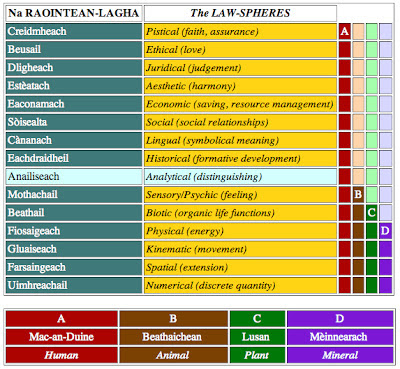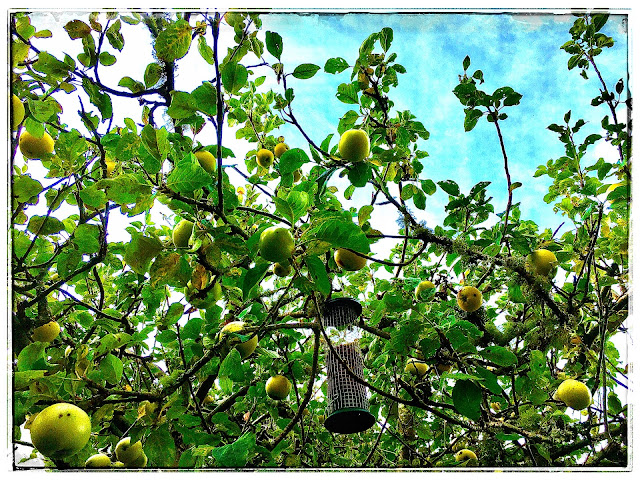Let us take as our example the individuality structure of an apple tree. This tree without a doubt functions in the first three aspects of reality: those of number, space and motion. So long as we leave aside the typical structure of the individual whole the tree does not yet exhibit any individuality types in these aspects whereby it would portray its particular nature. That changes as soon as we zero in on the aspect [aka modality, law-sphere etc (see diagram below)] of organic life as it finds its typical place in the structure of the tree. Here the tree as such displays an original or nuclear type of individuality which simply cannot be dispensed with.
What place does this modal aspect then occupy in the structural whole of the tree? It is the function of organic life, which is the last subject function that the tree has in the order of the modal aspects. In all later aspects the tree has only object functions. A tree has no subjective feelings or sensations, but it does have objective properties in the sensitive aspect, which, standing as it does in typical intermodal relations with the biotic, physical, spatial and numerical aspects, can function only in a structural relation with possible subjective sensations. The tree does not think as a subject, but it is thought of in its objective logical characteristics which exist only for possible subjective concept formation. It is not the subject of cultural activity in the historical aspect, but it can become a cultural object, just as it has structural object functions in all later aspects, which, however, can be disclosed or realized only by humanity. A tree possesses potential object functions even in the moral and the faith aspect, functions that are part and parcel of the tree’s full temporal structure. It can become an object of love or hate and an object of faith.
Object functions of natural things in the moral and faith aspectIf there is anything that is imprinted on us by Holy Scripture, it is this integral character of the temporal reality of natural things. The notion, imported into the view of reality by both the Greek substance-concept and the humanist science ideal, that normative qualities [the normative modalities are the analytical aspect and all those aspects above it on the chart below)] do not belong to the “thing in itself” but rest exclusively on the subjective appreciation of human consciousness—this notion is definitely unscriptural and at odds with the primary given of our naive experience of reality.
Christ Jesus in faith rebukes the storm, and it subsides; he curses the fig tree that bore no fruit, and it withers; he blesses the few loaves and fish, and they feed thousands. Modern science in its pride explains these miracles away; the supernaturalism of Roman Catholicism has these miracles take place in circumvention of “nature.” If the Reformational view rejects both positions, how can one at the same time uphold a philosophical view of reality which denies natural things all objective reality in the moral sphere and the sphere of faith?
For that matter, this view of reality is self-refuting. For example,whoever follows the natural science ideal and ascribes real existence to the tree only in the aspects that are investigated by mathematics-based natural science, such a person is guided by the faith that the tree is merely a “product of nature.” To think that natural science teaches this is a naive misunderstanding. For science begins by consciously setting aside all aspects that it is not interested in. But the subjective faith in question, which is in conflict with the Christian belief in creation, pertains to an objective state of affairs in the sphere of faith. Either the tree is objectively a creature of God, or it is not; therefore it ought to be either the object of belief in creation or else an object of faith in the sovereignty of natural science.
Whoever claims truth for his faith cannot deny the subject-object relation in the sphere of faith. To attain a proper understanding in subject-object relations one should of course bear in mind that the object functions of natural things in the moral and faith aspect are of a fundamentally normative character. That means that the disclosure and realization of these functions by man can take place not only as conforming to but just as well as in conflict with the modal norms in question.
In a pagan society, for example, a tree can play an objective, idolatrous role in the life of faith, in the same way as a tree under the idolatry of the naturalistic science ideal turns into an object of idolatrous faith in the dominant power of natural science. But it is always related to reality-based objective states of affairs which are potentially present (i.e., by predisposition) in the structure of natural things and which cannot be reduced to purely subjective vantage points from which human consciousness views things.
The curse that man’s fall into sin brought down on the whole earth is a reality. Out of the faith aspect it pervades all aspects of reality. It does not leave intact the reality of natural things that are created with a temporal structure. Within the temporal horizon there is no such thing as a Ding an sich whose reality is closed off in the pre-logical aspects [ie aspects beneath the “analytical” law sphere on the diagram below] and so falls outside structural subject-object relations in the normative law-spheres.
(Extract from ‘Reformation and Scholasticism’ Vol 2, pp 250-252)
Free download of this and other Dooyeweerd books HERE
 |
LAW-SPHERES of COSMIC TIME
(Also called Aspects/ Modes of Consciousness/ Modalities/ Modes of Meaning) |
